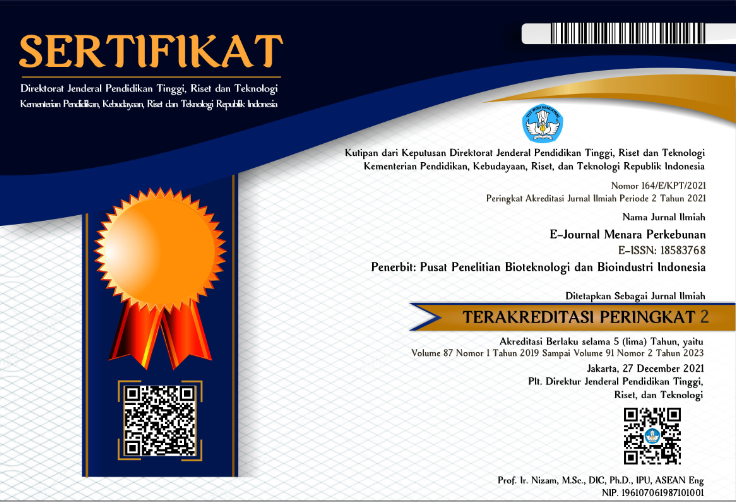Solubilization of insoluble phosphates by Aspergillus niger Pelarutan fosfat sukar larut oleh Aspergillus niger
DOI:
https://doi.org/10.22302/iribb.jur.mp.v68i2.142Keywords:
P solubilization, Aspergillus niger, rock phosphateAbstract
Ringkasan
Penggunaan langsung fosfat alam (FA) ke dalam tanah sebagai sumber pupuk P telah dilakukan selama bertahun-tahun melalui beberapa macam cara penggunaan. Kualitas FA di Indonesia umumnya rendah dan ketersediaan bahan baku yang berkualitas untuk produksi pupuk fosfat terlarut relatif terbatas. Beberapa mikroba asal tanah yang dapat melarutkan fosfat anorganik telah banyak dilaporkan. Namun, informasi yang tersedia tentang mekanisme pelarutan P dari FA lokal asal Indonesia dan P anorganik oleh Aspergillus niger BCC F194 belum banyak diteliti. Satu seri penelitian laboratorium telah dilaksanakan untuk mengetahui kemampuan A. niger BCC F194 melarutkan P. Evaluasi agronomi FA lokal (FA Cileungsi dan Madura) di rumah kaca juga telah dilakukan. A. niger BCC F194 dapat melarutkan sumber P sukar larut, yaitu FA Cileungsi dan Madura, serta senyawa Ca3(PO4)2 dan AlPO4. Kelarutan P anorganik tersebut berhubungan dengan peningkatan aktivitas proton (H*) yang menyebabkan penurunan pH medium dan produksi asam organik. Asam organik utama yang dihasilkan oleh A. niger BCC F194 dalam medium cair Pikovskaya yang dimodifikasi adalah asam oksalat (3.75 mM), asam sitrat (2.0 mM), dan asam glukonat (0.9 mM). Kelarutan FA Cileungsi lebih besar dibandingkan dengan FA Madura, dan kelarutan Ca3(PO4)2 lebih besar dibandingkan kelarutan AlPO4. Tidak ada korelasi antara kelarutan P anorganik dengan aktivitas enzim fosfatase, walaupun aktivitas enzim fosfatase cukup tinggi terdeteksi dalam medium. Satu formula biosuperfosfat telah berhasil dirakit dengan mereaksikan FA lokal dengan supernatan kultur cair (SKC) pengganti asam sulfat. Hasil percobaan pada
bibit kakao, karet dan kelapa sawit di rumah kaca menunjukkan bahwa prototipe pupuk biosuperfosfat dengan bahan
baku FA Cileungsi dan Madura bentuk granul maupun serbuk, memiliki nilai efektivitas agronomi yang relatif menyamai SP-konvensional.
Summary
The direct application of rock phosphate (RP) to soils as a source of phosphorus (P) fertilizer has been employed with varying popular methods over the years. The RP in Indonesia has low quality for plant fertilization and the availability of the raw material with good quality for production of soluble phosphate fertilizers is limited. Many common soil microbes that can dissolve insoluble inorganic phosphate have been extensively studied. However, there is little information on mechanism of P-solubilization from local RP of Indonesia and inorganic P by Aspergillus niger BCC F194 isolated from tropical acid soils. A laboratory study was conducted to determine the ability of phosphate solubilization A. niger BCC F194. Agronomic evaluation of bioactivated local RP, i.e. Cileungsi and Madura phosphate rocks (CRP and MRP) for direct application in greenhouse experiment was also conducted. A. niger BCC F194 was able in solubilizing different types of hardly-soluble phosphates, i.e. CRP and MRP, Ca3(PO4)2, and AlPO4 compounds. Inorganic P solubilization was directly correlated to the organic acid production and increasing proton (H+) activities causing pH to decrease and production of organic acid. The major acidic metabolites produced by A. niger BCC F 194 in modified liquid culture Pikovskaya medium were oxalic acid (3.75 mM), citric acid (2.0 mM), and gluconic acid (0.9 mM). The solubilization of Cileungsi RP was higher than that of Madura RP, and the solubilization of Ca3(PO4)2 was better than that of AlPO4. No correlation between solubilization of inorganic P and enzyme activities, although high activities of phosphatase enzyme were detectable in the medium. A biosuperphosphate formula had been constructed by reacting local RP with liquid culture supernatant (LCS) replacing sulfuric acid. Results of cocoa, rubber, and oil palm seedlings experiments in greenhouse indicate that both granular and powder biosuperphosphate prototypes commonly had a comparable relative agronomic effectiveness value to that of the conventional SP.
Downloads
Downloads
Submitted
Accepted
Published
How to Cite
Issue
Section
License
Authors retain copyright and grant the journal right of first publication with the work simultaneously licensed under a Creative Commons Attribution License that allows others to share the work with an acknowledgement of the work's authorship and initial publication in this journal.













